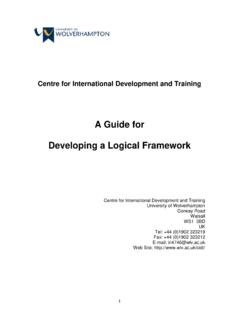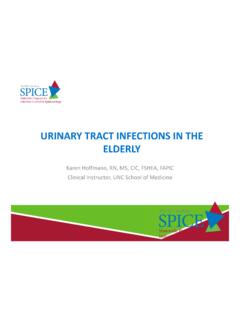Transcription of Topic 7—Mitigation and impact management
1 EIA Training Resource Manual u Second edition 2002 303 Training session outline Topic 7 Mitigation and impact management Topic 7 Mitigation and impact management Objectives To understand the role of mitigation in the EIA process and its importance for impact management . To identify the principles, elements of approach and measures that are used for this purpose. Relevance Mitigation is the stage of the EIA process when measures are identified to avoid, minimise or remedy impacts. These measures are implemented as part of the process of impact management , together with any necessary adjustments to respond to unforeseen impacts. Both elements are integral to ensuring that the EIA process leads to practical action to offset the adverse environmental impacts of proposed developments.
2 Timing Two hours (not including training activity) Important note to trainers You should design your presentation with the needs and background of participants in mind, and concentrate on those sections most relevant to your audience. The session presentation timings are indicative only. Time taken for the training activities can vary enormously depending on the depth of treatment, the existing skills and knowledge of participants and the size of the group. 304 EIA Training Resource Manual u Second edition 2001 Training session outline Information checklist Obtain or develop the following, as appropriate: o EIA reports (preferably local) and associated approval conditions that have been used to generate and implement impact management plans; o examples of the successful design and implementation of measures as a result of EIA; o copies or results of any research focused on mitigation or impact management , and if possible relevant information from monitoring, audit and other follow up measures; o contact names and telephone numbers of people, agencies, organizations and environmental information data resource centres able to provide assistance in mitigation or impact management .
3 And o other resources that may be available, such as courses in specific analytical or methodological techniques, videos, journal articles, computer programmes, lists of speakers, and case studies. EIA Training Resource Manual u Second edition 2002 305 Training session outline Topic 7 Mitigation and impact management Session outline Welcome participants to the session. Outline the overall coverage of the session, its objectives and why these are important in the EIA process. The purpose of mitigation is to identify measures that safeguard the environment and the community affected by the proposal. Mitigation is both a creative and practical phase of the EIA process. It seeks to find the best ways and means of avoiding, minimising and remedying impacts. Mitigation measures must be translated into action in the correct way and at the right time if they are to be successful.
4 This process is referred to as impact management and takes place during project implementation. A written plan should be prepared for this purpose, and includes a schedule of agreed actions. Introduce the link between the EIA process and the mitigation of adverse impacts. Broadly discuss what mitigation seeks to achieve. Mitigation is a critical component of the EIA process. It aims to prevent adverse impacts from happening and to keep those that do occur within an acceptable level. Opportunities for impact mitigation will occur throughout the project cycle. The objectives of mitigation are to: find better alternatives and ways of doing things; enhance the environmental and social benefits of a proposal; avoid, minimise or remedy adverse impacts; and ensure that residual adverse impacts are kept within acceptable levels.
5 Early links should be established between the EIA and project design teams to identify mitigation opportunities and incorporate them into consideration of alternatives and design options. In practice, mitigation is emphasised in the EIA process once the extent of the potential impact of a proposal is reasonably well understood. This typically takes place following impact identification and prediction, and recommended measures for mitigation will be an important part of the EIA report. Usually, these measures will be incorporated into the terms and conditions of project approval and implemented during the impact management stage of the EIA process. The objectives of impact management are to: ensure that mitigation measures are implemented; establish systems and procedures for this purpose; 1 2 306 EIA Training Resource Manual u Second edition 2001 Training session outline monitor the effectiveness of mitigation measures; and take any necessary action when unforeseen impacts occur.
6 Discuss the proponent s responsibility for implementing mitigation and the potential long-term benefits to the proponent of appropriate mitigation. The adverse impacts and consequences of a proposal can occur far beyond the site boundaries of a project. In the past, many of the real costs of development proposals were not accounted for in economic analyses of project feasibility, particularly in the operational and decommissioning phases of the project cycle. As a result, these costs were borne by the community affected or the public at large rather than by the proponent. Stricter requirements are now being imposed on proponents to: mitigate impacts through good project design and environmental management ; provide benefits to the community affected by the proposal; prepare plans for managing impacts so these are kept within acceptable levels; and make good any residual environmental damage.
7 The responsibility of proponents to internalise the full environmental costs of development proposals is now widely accepted. In addition, many proponents have found that good design and impact management can result in significant savings. This outcome is similar to that found in industries applying the principles of cleaner production to improve their environmental performance. Like cleaner production, mitigation measures are more expensive in capital outlay but have been found to be cost effective over the long run. The sustainability agenda is placing new demands on proponents with regard to mitigation and impact management . For example, increasing attention is being given to the principle of no net loss of natural and social capital . Under the polluter pays principle, the application of this principle could require the proponent to make restitution for unavoidable residual damages.
8 In this case, mitigation would include in-kind compensation measures, comprising equivalent, comparable or suitable offsets for all residual environmental impacts of a proposal. Briefly discuss the main elements of mitigation and principles for their application. Consider how these might be used as part of EIA good practice locally. 3 EIA Training Resource Manual u Second edition 2002 307 Training session outline Topic 7 Mitigation and impact management In Figure 1 below, the elements of mitigation are organised into a hierarchy of actions: first, avoid adverse impacts as far as possible by use of preventative measures; second, minimise or reduce adverse impacts to as low as practicable levels; and third, remedy or compensate for adverse residual impacts, which are unavoidable and cannot be reduced further.
9 Key principles for the application of mitigation consistent with the above framework include the following: give preference to avoid and prevent measures; consider feasible alternatives to the proposal and identify the best practicable environmental option; identify customised measures to minimise each of the main impacts predicted; ensure they are appropriate, environmentally sound and cost-effective; and use compensation or remedial measures as a last resort. EIA good practice in mitigation requires a relevant technical understanding of the issues and the measures that work in the circumstances. Mitigation can be carried out by: structural measures, such as design or location changes, engineering modifications and landscape or site treatment; and non-structural measures, such as economic incentives, legal, institutional and policy instruments, provision of community services and training and capacity building.
10 Structural measures are well established for certain types of projects, such as dams, roads, and oil and gas exploration and development. In some cases, industry codes of good practice will be available. However, these need to be applied with regard to the nature and severity of environmental impacts; for example taking account of nearby protected areas, patterns of wildlife mitigation or constraints imposed by natural hazards. Other projects involving new technology may require non-standardised or even untried measures to mitigate the adverse impacts. These need to be given special attention during impact management . Non-structural measures are used increasingly. They can be applied to reinforce or supplement structural measures or to address specific impacts.






